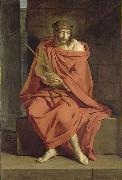Wholesale Oil Painting No Minimum |
|||||||||||
|
|
|||||||||||

|
|||||||||||
|
|
|
||||||||
Philippe de Champaigne1602-1674 Philippe de Champaigne Locations His artistic style was varied: far from being limited to the realism traditionally associated with Flemish painters, it developed from late Mannerism to the powerful lyricism of the Baroque. It was influenced as much by Rubens as by Vouet, culminating in an aesthetic vision of the world and of humanity that was based on an analytic view of appearances and on psychological truth. He was perhaps the greatest portrait painter of 17th-century France. At the same time he was one of the principal instigators of the Classical tendency and a founder-member of the Acadmie Royale de Peinture et de Sculpture. His growing commitment to the Jansenist religious movement (see JANSENISM) and the severe plainness of the works that it inspired has led to his being sometimes considered to typify Jansenist thinking, with its iconoclastic impulse, in spite of the opposing evidence of his other paintings. He should be seen as an example of the successful integration of foreign elements into French culture and as the representative of the most intellectual current of French painting. |
||||||||
|
|
||||||||
eccehomo
eccehomo Painting ID:: 74238 |
Description Ecce Homo
Date XVIIe siecle
Source/Photographer Huile sur toile
Permission
(Reusing this file) See below.
cyf Description Ecce Homo Date XVIIe siecle Source/Photographer Huile sur toile Permission (Reusing this file) See below. cyf |
|||||||
|
CONTACT US |

